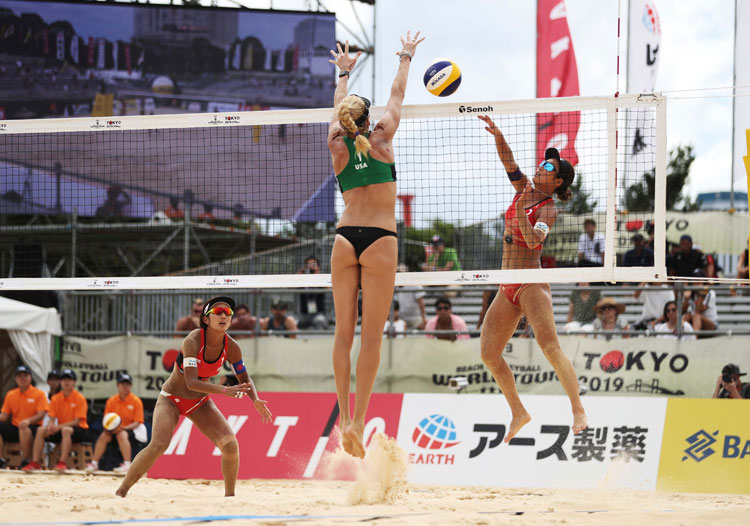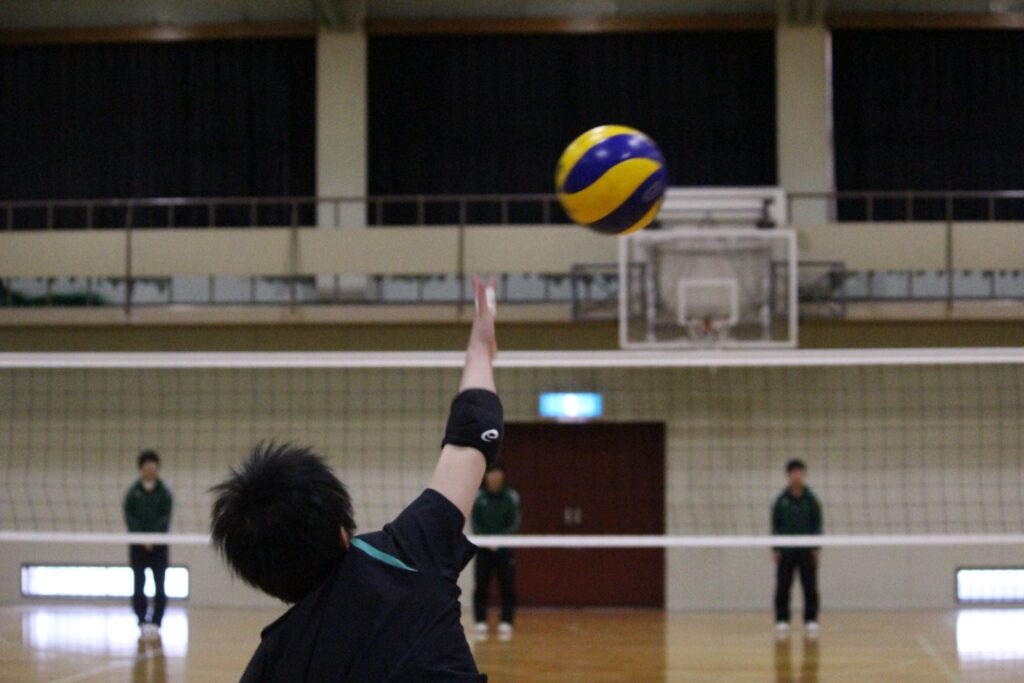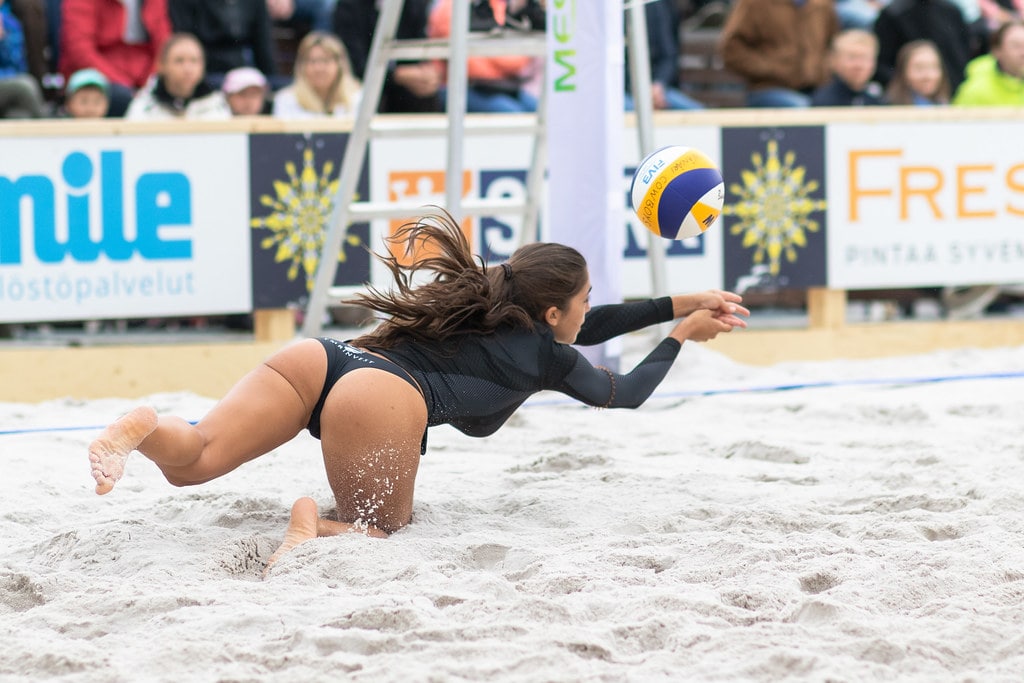
When enjoying beach volleyball, receiving is one of the important techniques that influences the flow of the game.
In order to improve, you not only need to practice, but also need proper form, situational awareness, and the ability to read your opponent’s intentions.
There are points that all players, from beginners to advanced players, should strive to improve, but getting the hang of receiving is especially essential to gaining an advantage in the game.
This article will cover a wide range of ways to improve your beach volleyball receiving skills, from basic posture to applied techniques, as well as common mistakes and countermeasures.
Successful receiving improves your team’s defense and smoothes the transition to offense, so honing this skill is key to taking your beach volleyball performance to the next level.
Let’s start with the basics of beach volleyball receiving.
目次
- 1 Basic knowledge of beach volleyball receiving
- 2 Practice methods to improve receiving technique
- 3 Common mistakes and their countermeasures
- 4 Receive techniques for advanced players
- 5 summary
Basic knowledge of beach volleyball receiving
Receiving in beach volleyball is an important first step in accurately processing the opponent’s serve or attack and creating attacking opportunities for your team.
Beach volleyball, played on the sand, requires different techniques and tactics than indoor volleyball.
Therefore, in order to successfully receive, basic knowledge and techniques unique to beach volleyball are required.
Basic posture for successful reception
positioning
The basics of receiving start with proper positioning. When receiving a serve, bend your knees slightly, take a low stance, and shift your weight forward. This will keep you in a position to move quickly.
How to use your hands
Clasp your hands in front of your chest and extend your arms ready to receive the ball. It is important to keep your palms firmly open to the ball and to control the ball accurately. It is also important to stabilize your wrists to help absorb the impact of the ball.
line of sight
Always keep your eyes focused on the ball so you don’t lose sight of it. Accurately reading the trajectory and speed of the ball will lead to effective reception.
Receiving tips specific to beach volleyball
movement on the sand
Because your feet sink into the sand, your movements tend to be slower than when playing indoors. Therefore, try to adjust your positioning quickly by taking small and quick steps. It is also important to move efficiently using the entire sole of your foot to avoid getting caught in the sand.
How to read the wind
Beach volleyball is played outdoors and is therefore affected by the wind. It is a good idea to constantly check the direction and strength of the wind, and if the ball is flying upwind, adjust your positioning slightly forward, and if it is downwind, adjust your positioning back.
communication
Beach volleyball is mostly played in two-person format. Therefore, communication with your partner is very important. When deciding which ball to receive, call clearly to reduce unnecessary movement and lead to efficient reception.
In order to master beach volleyball receiving, it is important to understand these basic postures and beach volleyball-specific tips and apply them in practice.
By practicing repeatedly, you will be able to acquire more advanced techniques and gain an advantage in the game.
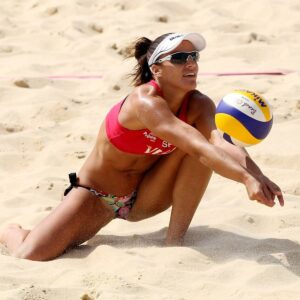
Practice methods to improve receiving technique
Receiving techniques in beach volleyball are the foundation for building an effective team attack.
Correct practice methods and continuous training are essential to improving receiving accuracy.
Here we will introduce effective receiving practice drills and useful receiving techniques in practice.
Effective receiving practice drills
Positioning and footwork exercises
- Shadow Drill : Performed without a partner, this drill involves quickly moving to the position where you expect to receive the serve and assuming a receiving position. Through this exercise, you will develop proper positioning and footwork.
Improved ball control
- Wall-hitting drill : Hit the ball against the wall and use a receiving motion to return the ball. Improve your hand and ball sensation by controlling the ball continuously.
Enhanced reaction speed and accuracy
- Random Serve Drill : Partners serve randomly and aim to receive accurately each time. This drill is effective for developing reaction speed and accuracy for unpredictable serves.
Useful receiving techniques in practice
Body alignment when receiving
- Receive using the whole body : When receiving, use your whole body to control the ball by moving it forward. This allows you to send the ball consistently to the setter.
Reading and prediction
- Read the server’s movements : Observe the server’s standing position and hand shape before the serve to predict the direction and speed of the serve. This reduces reaction time and allows for more effective receiving.
importance of communication
- Communicate vocally : It is important to communicate vocally to make it clear who is responsible for receiving the ball. This improves the accuracy of receiving as a team.
By incorporating these practice methods and techniques, you can expect to improve your receiving techniques in beach volleyball.
Aim for a higher level of play through continuous practice and practice in matches.
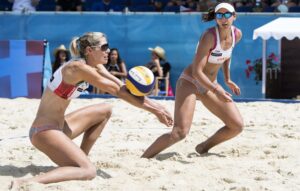
Common mistakes and their countermeasures
Receiving is the most basic technique in beach volleyball, but it is also an important technique that influences the flow of the match.
However, it is not easy to be perfect at receiving, and many players tend to make similar mistakes.
Here we will explain common mistakes when receiving and how to counter them.
What are common mistakes when receiving?
inaccurate positioning
Many receiving failures begin with inaccurate positioning. If you are slow to react to a serve or attack and are not properly positioned for the ball, it will be difficult to receive effectively.
failure of body balance
If your body is out of balance, you will not be able to receive the ball stably. Maintaining your balance becomes even more difficult, especially on sand.
losing sight of the ball
I can’t keep up with the speed of serves and attacks, and I often lose sight of the ball. The moment you lose concentration on the ball, it can lead to mistakes.
Tips to avoid mistakes
Prediction and preparation
Even before the serve is made, carefully observe the opponent’s movements and predict the direction and speed of the serve. Also, in preparation for receiving a serve, it is important to always bend your knees and keep a low posture so that you can move quickly.
keep balance
To maintain your balance, spread your feet shoulder-width apart and bend your knees slightly to keep your center of gravity low. In order to get used to moving on the sand, it is effective to practice moving while keeping your balance.
keep watching the ball
Keeping your eye on the ball is essential for effective receiving. From the moment the serve is hit, keep your eyes on the ball until it reaches you. This requires concentration, but can be improved with practice.
By understanding and practicing these common mistakes and countermeasures, you can improve your receiving technique.
In a beach volleyball match, each reception is extremely important. Always prepare, stay focused, and aim for effective receiving.
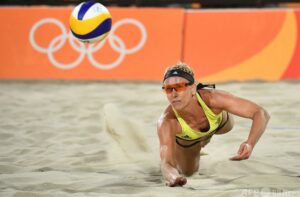
Receive techniques for advanced players
Receiving in beach volleyball is not just about returning the ball to the opponent’s court, but it is also an important technique for controlling the game and putting pressure on the opponent.
As you become an advanced player, you will need more advanced techniques and strategies that go beyond basic receiving techniques.
Here, we’ll explore receiving techniques for advanced players, how to learn them, and receiving strategies to outwit your opponents.
How to learn advanced receiving techniques
Diving receive practice
- Purpose : This technique involves throwing your body onto the ground to receive the ball, even if it seems out of reach.
- How to practice : Practice your diving form in a safe environment. Start at a low height and gradually increase your movements. Learn the techniques to extend your reach to your limit while protecting your body with proper form.
Improved receiving accuracy
- Purpose : A technique to send the received ball to the setter more accurately.
- Training method : We perform drills that aim to accurately send the ball to a specific location, making extensive use of cooperative play with partners. Set a target point and practice sending the ball as close to that point as possible.
Receiving strategy to outwit your opponent
fake receive
- Summary : This is a technique that throws off your opponent’s predictions by pretending to receive and changing direction at the last moment.
- How to use : Effective against opponents who are good at strong serves or who play in a specific pattern. Watch your opponent’s reaction and time the fake.
Utilization of short receive
- Overview : This is a technique that disrupts the opposing team’s defensive structure by cutting the serve-receive short and moving the opponent’s forward players. This strategy is especially effective when the opposing team has a strong offensive line or when the opponent’s defense is solid.
How to practice
- Control Drill : This drill increases the accuracy of your short receptions by intentionally making short receptions to specific areas. Work with your partner to target different areas of the court and aim to land a reception within that area.
Application in practice
- Reading the game development : Read the opponent’s movements and the flow of the game, and determine when a short reception is effective. Opportunities are when the opposing team is standing back and solidifying their defense, or when their front players are distracted by their backs.
Master the receiving breaking ball
topspin receive
- Purpose : This is an advanced technique that adds rotation to the receive, making it difficult for the opponent to predict the receiver and making it difficult to receive the receive.
- How to practice : To create topspin, use your wrists to snap upwards as soon as you touch the ball. To practice this movement, you can develop a sense of applying precise rotations by hitting the ball against a wall or practicing tossing with a partner.
Change of position when receiving serve
- Overview : This is a strategy that disrupts the opponent’s attack pattern and increases receiving efficiency by intentionally making changes to the standard receiving formation.
- How to put it into practice : Analyze the opponent’s attack patterns during pregame warm-ups and during timeouts during games, and share with your team the optimal receiving formation to respond to those attacks. During matches, players proactively change formations and read and respond to their opponent’s strategies.
By mastering these advanced receiving techniques and strategies, you can greatly increase your team’s advantage in beach volleyball matches.
Advanced receiving techniques can be acquired through lots of practice and practical experience.
Continue to practice and try using different strategies in your matches.
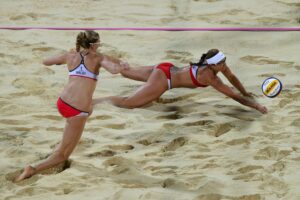
summary
Receiving technique in beach volleyball is an important element that can determine the success or failure of a match.
Effective receiving requires a wide range of knowledge and skills, from basic receiving postures and tips to advanced techniques and strategies for advanced players.
From basic positioning, footwork, and ball handling methods that beginners should master, to advanced techniques such as diving reception, fake reception, and short reception that advanced players can use to further improve their skills, through continuous practice and games. It is important to hone your skills through practice.
In beach volleyball, it is necessary to consider the unique environment of being on the sand and external factors such as the wind, and it is also necessary to have the flexibility to choose the optimal receiving method based on these factors.
In addition, a high degree of strategic ability is essential for improving receiving skills, such as communicating closely with teammates, deciphering the opposing team’s strategy, and taking countermeasures.
By practicing the methods and strategies for learning receiving techniques introduced in this article, players will be able to approach games with confidence and make a significant contribution to their team’s victory.
Improving your receiving technique will also lead to improving your overall beach volleyball technique, so practice actively and aim for even greater heights.
